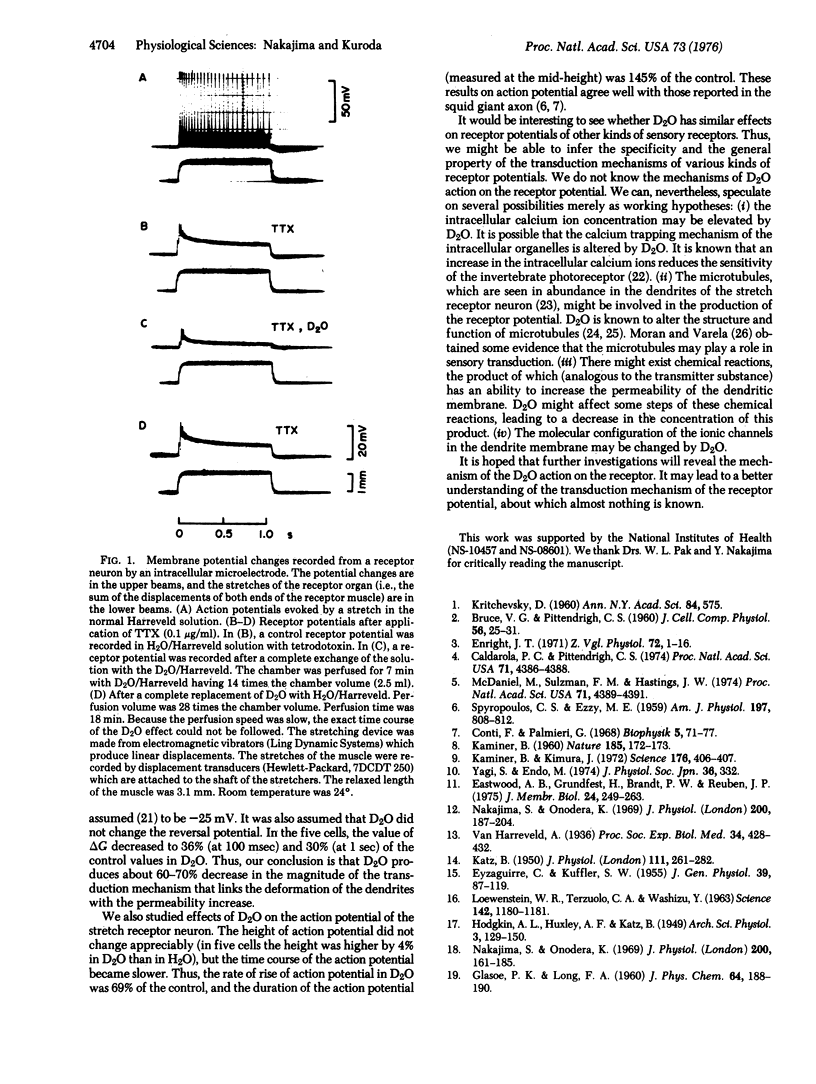Abstract
In the crayfish stretch receptor organ, a total substitution of D2O for H2O in the bathing solution produced a decrease in the amplitude of the receptor potential to a level of 34% of the control. The electrical resistance of the receptor neuron was slightly increased by the D2O substitution. The input capacitance of the neuron was unchanged. The viscoelastic properties of the receptor muscle were not altered by D2O. Thus, we conclude that D2O has an inhibitory effect on the transduction process which links the deformation of the dendrites with the permeability increase that is responsible for the receptor potential.
Full text
PDF


Selected References
These references are in PubMed. This may not be the complete list of references from this article.
- Caldarola P. C., Pittendrigh C. S. A test of the hypothesis that D2O affects circadian oscillations by diminishing the apparent temperature. Proc Natl Acad Sci U S A. 1974 Nov;71(11):4386–4388. doi: 10.1073/pnas.71.11.4386. [DOI] [PMC free article] [PubMed] [Google Scholar]
- Conti F., Palmieri G. Nerve fiber behaviour in heavy water under voltage-clamp. Biophysik. 1968 Aug 12;5(1):71–77. doi: 10.1007/BF01388134. [DOI] [PubMed] [Google Scholar]
- EYZAGUIRRE C., KUFFLER S. W. Processes of excitation in the dendrites and in the soma of single isolated sensory nerve cells of the lobster and crayfish. J Gen Physiol. 1955 Sep 20;39(1):87–119. doi: 10.1085/jgp.39.1.87. [DOI] [PMC free article] [PubMed] [Google Scholar]
- Eastwood A. B., Grundfest H., Brandt P. W., Reuben J. P. Sites of action of D2O in intact and skinned crayfish muscle fibers. J Membr Biol. 1975 Dec 4;24(3-4):249–263. doi: 10.1007/BF01868626. [DOI] [PubMed] [Google Scholar]
- Inoué S., Sato H. Cell motility by labile association of molecules. The nature of mitotic spindle fibers and their role in chromosome movement. J Gen Physiol. 1967 Jul;50(6 Suppl):259–292. [PMC free article] [PubMed] [Google Scholar]
- KAMINER B. Effect of heavy water on different types of muscle and on glycerol-extracted psoas fibres. Nature. 1960 Jan 16;185:172–173. doi: 10.1038/185172a0. [DOI] [PubMed] [Google Scholar]
- KATZ B. Depolarization of sensory terminals and the initiation of impulses in the muscle spindle. J Physiol. 1950 Oct 16;111(3-4):261–282. doi: 10.1113/jphysiol.1950.sp004479. [DOI] [PMC free article] [PubMed] [Google Scholar]
- KRITCHEVSKY D. Deuterium in biology. Ann N Y Acad Sci. 1960 Nov 25;84:575–575. doi: 10.1111/j.1749-6632.1960.tb39089.x. [DOI] [PubMed] [Google Scholar]
- Kaminer B., Kimura J. Deuterium oxide: inhibition of calcium release in muscle. Science. 1972 Apr 28;176(4033):406–407. doi: 10.1126/science.176.4033.406. [DOI] [PubMed] [Google Scholar]
- LOEWENSTEIN W. R., TERZUOLO C. A., WASHIZU Y. SEPARATION OF TRANSDUCER AND IMPULSE-GENERATING PROCESSES IN SENSORY RECEPTORS. Science. 1963 Nov 29;142(3596):1180–1181. doi: 10.1126/science.142.3596.1180. [DOI] [PubMed] [Google Scholar]
- Lisman J. E., Brown J. E. The effects of intracellular iontophoretic injection of calcium and sodium ions on the light response of Limulus ventral photoreceptors. J Gen Physiol. 1972 Jun;59(6):701–719. doi: 10.1085/jgp.59.6.701. [DOI] [PMC free article] [PubMed] [Google Scholar]
- MARTIN A. R. A further study of the statistical composition on the end-plate potential. J Physiol. 1955 Oct 28;130(1):114–122. doi: 10.1113/jphysiol.1955.sp005397. [DOI] [PMC free article] [PubMed] [Google Scholar]
- McDaniel M., Sulzman F. M., Hastings J. W. Heavy water slows the Gonyaulax clock: a test of the hypothesis that D2O affects circadian oscillations by diminishing the apparent temperature. Proc Natl Acad Sci U S A. 1974 Nov;71(11):4389–4391. doi: 10.1073/pnas.71.11.4389. [DOI] [PMC free article] [PubMed] [Google Scholar]
- Moran D. T., Varela F. G. Microtubules and sensory transduction. Proc Natl Acad Sci U S A. 1971 Apr;68(4):757–760. doi: 10.1073/pnas.68.4.757. [DOI] [PMC free article] [PubMed] [Google Scholar]
- Nakajima S., Onodera K. Adaptation of the generator potential in the crayfish stretch receptors under constant length and constant tension. J Physiol. 1969 Jan;200(1):187–204. doi: 10.1113/jphysiol.1969.sp008688. [DOI] [PMC free article] [PubMed] [Google Scholar]
- Nakajima S., Onodera K. Membrane properties of the stretch receptor neurones of crayfish with particular reference to mechanisms of sensory adaptation. J Physiol. 1969 Jan;200(1):161–185. doi: 10.1113/jphysiol.1969.sp008687. [DOI] [PMC free article] [PubMed] [Google Scholar]
- Nakajima Y., Tisdale A. D., Henkart M. P. Presynaptic inhibition at inhibitory nerve terminals. A new synapse in the crayfish stretch receptor. Proc Natl Acad Sci U S A. 1973 Aug;70(8):2462–2466. doi: 10.1073/pnas.70.8.2462. [DOI] [PMC free article] [PubMed] [Google Scholar]
- Obara S. Effects of some organic cations on generator potential of crayfish stretch receptor. J Gen Physiol. 1968 Aug;52(2):363–386. doi: 10.1085/jgp.52.2.363. [DOI] [PMC free article] [PubMed] [Google Scholar]
- Van Obberghen E., Somers G., Devis G., Ravazzola M., Malaisse-Lagae F., Orci L., Malaisse W. J. Dynamics of insulin release and microtubular-microfilamentous system. VI. Effect of D2O. Endocrinology. 1974 Dec;95(6):1518–1528. doi: 10.1210/endo-95-6-1518. [DOI] [PubMed] [Google Scholar]
- Yagi S., Endo M. [Proceedings: Effect of heavy water on excitation-contraction mechanism]. Nihon Seirigaku Zasshi. 1974 Sep 1;36(8-9):332–332. [PubMed] [Google Scholar]


